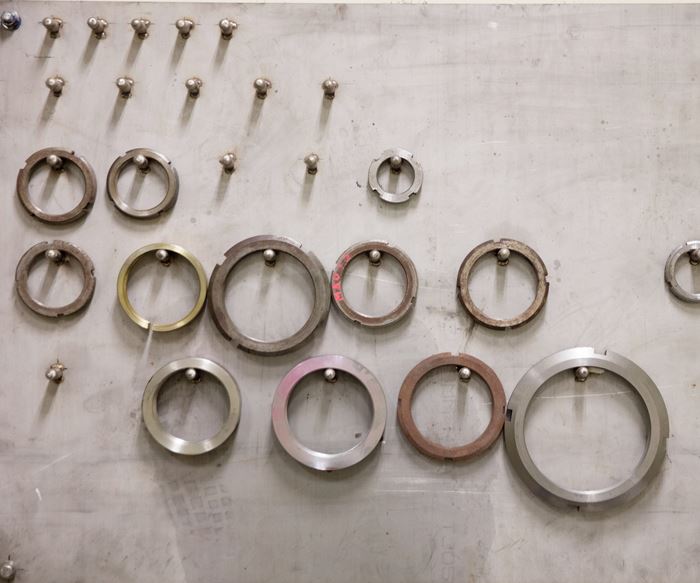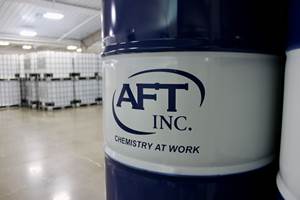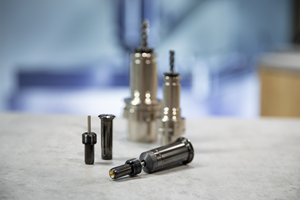3 Types of Insights from Used Oil Analysis (UOA)
Monitoring the condition of lubricants through UOA helps machine shops glean critical insights that can limit downtime and keep equipment running.
Share




ECi Software Solutions, Inc.
Featured Content
View More

.png;maxWidth=45)
DMG MORI - Cincinnati
Featured Content
View More
Hwacheon Machinery America, Inc.
Featured Content
View More

To meet higher availability targets while keeping costs under control, many machine shops today are running their machines harder and with more time between scheduled maintenance. But, doing so means that operators have to do everything possible to optimize equipment reliability—making sure that pushing their equipment and extending maintenance cycles doesn’t backfire and actually lead to more downtime.
Achieving this goal starts with proper lubrication. This of course means using the right lubricants, namely high-quality fluids that are formulated for the application. But it also means implementing lubricant monitoring programs to properly assess lubricant and equipment condition. Specifically, I’m talking about used oil analysis (UOA).
UOA is fundamental to condition monitoring strategy, allowing equipment operators to pull oil samples from active equipment and send them to a lab for assessment, typically a lubricant partner’s lab. Based on the oil quality and contaminants observed, lab results provide equipment condition insights essential to making accurate maintenance decisions.
When integrated into a reliability program, UOA can deliver critical insights about equipment that help identify potential performance issues before they become a problem. UOA can help a shop run more efficiently and drive down maintenance costs.
To help underscore the value of this monitoring service, here are three types of insights that machine shop operators can glean from UOA results:
1. Metal Wear and Equipment Condition Insights
Wear metal particles are the most direct indicator of potential equipment problems. As equipment components begin to wear, trace metallic particles will become suspended in the oil, acting as a measuring stick for the amount of wear that has taken place. Since this is a lagging indicator of equipment degradation, it is important to quickly tie the equipment metallurgy to the UOA results and develop a plan for corrective action.
For example, if the UOA results for a hydraulic forging press reveal the presence of high levels of iron and copper contaminants, it might indicate that a component within the press is out of alignment, causing excessive wear. If caught early enough, maintenance personnel can prevent premature equipment failure, helping avoid downtime and costly maintenance.
When identifying metallurgical makeup, operators should reference the OEM material list for their equipment, but can also work with their lubricant supplier to fully understand the implications of wear metal results.
2. Lubricant Condition Insights
UOA can help operators measure a lubricant’s physical properties, which can help identify abnormal lubricant conditions before they lead to any performance challenges.
Here are a few common abnormalities and their potential impact on lubricant performance:
- High nitration rating. Nitration is a measure of the amount of nitrogen by-products in the oil, and it can provide invaluable insight into the likelihood of deposit formation from oil breakdown. Abnormal nitration levels often occur in defective seals, which can in turn lead to accelerated oxidation, the formation of acidic by-products in the oil, and oil thickening.
- High oxidation rating. Oxidation is a measurement of oil degradation. This can lead to shortened equipment life, oil filter plugging, equipment deposits, increased oil viscosity, and corrosion of metal parts. Oxidation can be caused by contamination, overheating, overextended oil drain intervals (ODIs) or the use of improper oil.
- High or low viscosity. Viscosity is a measure of a fluid’s resistance to flow at a given temperature. A sudden increase in viscosity can negatively impact the oil pressure and a lubricant’s ability to remove heat. A decrease in viscosity can negatively impact the lubricant’s ability to protect equipment. Changes in viscosity can be caused by contamination, oxidation, extended oil drains, high operating temperatures or use of an improper oil grade.
3. Insights from Potential Contaminants
Contamination is a leading cause of component wear and failure. Regular UOA can help identify the presence of potential contaminants when they first enter the system, and, if present, can help operators understand the source of the contamination to better address the challenge.
Here are some common UOA flags that may indicate presence of contaminants:
- High particle count. Particle count measures contaminant levels in the oil. A high particle count can lead to shortened equipment life, poor lubrication and accelerated wear. It can indicate an overextended ODI or that the lubricant has been contaminated by environmental or wear debris. The right air filters and breathers should be used to help manage particle count.
- High particle quantifier (PQ) index. PQ index measures the mass of metallic particles in the sample, and a high PQ index can indicate wear debris, metallic contamination and dirty filters. If left untreated, this can result in detrimental metal-to-metal contact, shortened equipment life and premature equipment failure.
- High High ultra centrifuge (UC) rating. UC rates the soluble submicron contaminants that can be precursors to system deposits, which can lead to erratic operation, intermittent failure, and shortened oil life. UC rating can increase due to high operating temperatures, overextended ODIs and improper oil in service.
Lubricant Monitoring Is Going Digital
Monitoring lubricant performance is only getting easier thanks to digital technologies. Where in the past samples might have been prone to transcription errors, there are now mobile scan-and-go oil analysis platforms, such as ExxonMobil’s Mobil Serv Lubricant Analysis which utilizes QR-coded labels for paperless lubricant sampling.
With this system, operators enter data directly into an online system and the sample’s data packet is delivered to the lab digitally. Results are returned through an online platform, reducing the time it takes to conduct UOA and increasing process efficiency.
Turning Insights into Results
UOA can reveal a range of important insights related to equipment and lubricant performance. Operators can turn these insights into results by taking corrective action as soon as possible.
Consider this real-world example from an ExxonMobil customer. A machine shop producing rolled ring forgings was experiencing equipment failure and unplanned downtime and needed to identify the source. After conducting UOA, our technical experts identified micropitting in the gearboxes of its ring mill as the source of failure.
Based on the UOA results, our technical experts recommended the company replace its conventional gear oil with a synthetic gear oil to improve reliability. As a result of the change, the company managed to improve machine reliability by preventing gearbox failures by reducing micropitting, in turn generating the company an estimated annual savings of $390,000.
Although used oil analysis can help operators tailor their maintenance programs to get more out of equipment, evaluating a single sample point may not be enough. When assessing equipment condition, operators should consider utilizing advanced oil analysis platforms that help identify high-level trends not typically recorded in individual sample reports in order to ensure accurate results. They can also work with their lubricant supplier or OEM to determine the proper control limits for each of these tests.
About the Author
Geoffrey Foulk
Geoffrey Foulk is a CLS-certified lubrication engineer based in Chicago, Illinois. He is responsible for key customer field engineering support of industrial lubricants in northern Illinois and Iowa.
Related Content
AFT's Semi-Synthetic Coolant Extends Sump Life
Advanced Cool 2200 provides high visibility while machining, keeping the machine and parts clean with no odor issues.
Read MoreSustainability Project Cuts Costs for Growing Manufacturer
A custom coolant and chip management system has helped Youngers and Sons lower its supply costs, improve its recycling margins and maintain a clean shop floor.
Read MoreBlaser Swisslube Coolant Minimizes Tool Wear When Machining Titanium
IMTS 2024: Skytec metalworking fluids are well suited for titanium machining because they minimize tool wear and reduce the number of tool changes without compromising process reliability.
Read MoreRego-Fix Toolholding System Reduces Coolant Consumption
MQL PG collets are designed for machines using one-channel, internal through-spindle MQL systems.
Read MoreRead Next
Registration Now Open for the Precision Machining Technology Show (PMTS) 2025
The precision machining industry’s premier event returns to Cleveland, OH, April 1-3.
Read MoreBuilding Out a Foundation for Student Machinists
Autodesk and Haas have teamed up to produce an introductory course for students that covers the basics of CAD, CAM and CNC while providing them with a portfolio part.
Read More5 Rules of Thumb for Buying CNC Machine Tools
Use these tips to carefully plan your machine tool purchases and to avoid regretting your decision later.
Read More





.png;maxWidth=150)
































.jpg;maxWidth=300;quality=90)



.jpg;maxWidth=300;quality=90)









